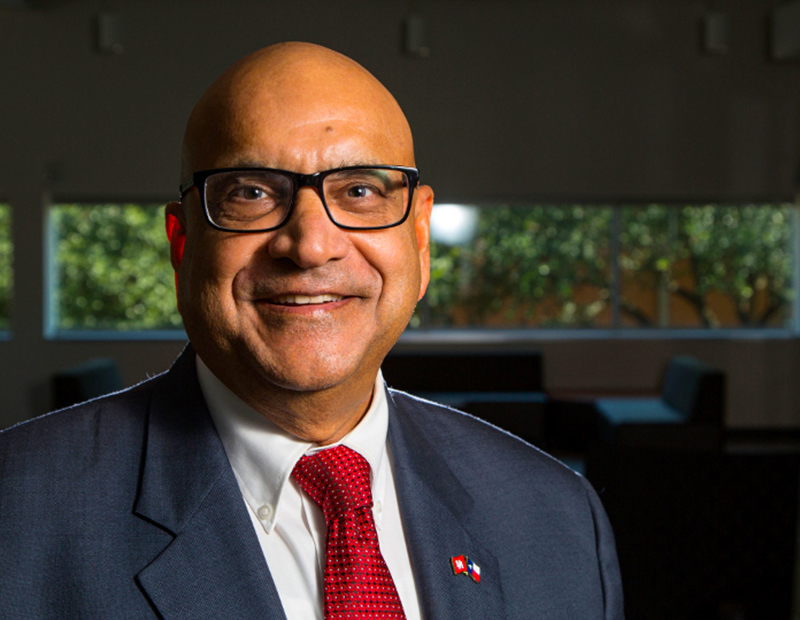An innovative partnership between the University of Houston and Oil India Ltd. (OIL) has offered benefits for both partners, boosting production in Oil India fields while providing UH researchers and graduate students with research opportunities and practical experience.
The $4.8 million partnership, launched in late 2016, completed its third phase in June 2021. This phase consisted of a project to enhance oil recovery in the fields in the Indian state of Assam, using carbon dioxide captured from nearby petrochemical plants. That project is slated to continue through 2022-23 (implementation time) and is designed to both increase the country’s ability to fulfill its energy needs and to reduce its carbon footprint. The collaboration has included training for Oil India executives and employees in Houston and India.
The project is led by Ganesh Thakur, Ph.D., Distinguished Professor of Petroleum Engineering and director of Energy Industry Partnership. It is an outgrowth of a trade mission to India led by Texas Gov. Greg Abbott in early 2016. Thakur, a member of the National Academy of Engineering, was recruited to UH in 2016 with a $3 million grant from the Governor’s University Research Initiative (GURI). This was matched by UH, for a total research budget of $6 million from 2016 to 2021.
“The Phase 3 research work involved more than 18 months of amazing teamwork between UH researchers and Oil India executives in the challenging pandemic time,” Thakur said. “The project in the past involved several US and India visits by both parties, but due to the Covid-19 situation, most of the weekly interactions happened by videoconferencing at midnight, Houston time. The UH researchers made real sacrifices, and the fruits of their hard work paid off in creating tremendous business impact.”
Thakur, a world recognized leader in reservoir management, Enhanced Oil Recovery (EOR) and Carbon Capture, Utilization and Storage (CCUS) is a former industry executive that spent years working with CCUS techniques for conventional wells in the Permian Basin for Chevron. In addition to Thakur, the UH team is composed of more than a dozen scientists and engineers, including faculty members, post-doctoral researchers and graduate students, in disciplines including petroleum engineering, chemical engineering and geosciences.
The initial MOUs for the partnership were signed in late 2016. Ratifying the agreement for the University of Houston were Chancellor and President Renu Khator, and Ramanan Krishnamoorti, Ph.D., Chief Energy Officer and Professor of Chemical & Biomolecular Engineering.
Durga D. Agrawal, Ph.D., a member of the UH System Board of Regents that was present when the MOUs for the project were signed, praised the collaborative work done by UH and Oil India to shepherd the project through another successful phase.
“The partnership between Oil India and the University of Houston’s Cullen College of Engineering is proof of the valuable contributions that we can make with expanded industry relations,” he said. “To foster further improvement at the College level and throughout our university system, creating more of these successful partnerships internationally and domestically is vital. As an alumni of the University of Houston, I’m proud to see international initiatives like this thrive.”
Completed work on the project includes:
- Phase 1 – The project began in December 2016 with a $500,000 Reservoir Screening Study and focused on analyzing wells in the Makum-North Hapjan field, located in the northeastern corner of India, in order to provide recommendations that could quickly boost oil production. More than 50 reservoirs were screened for EOR applications, containing more than 2.5 billion barrels of original oil-in-place.
- Phase 2 – This portion came with funding of $1.4 million, with an additional $325,000 for lab-based research. Among a number of significant accomplishments and recommendations, the UH team developed a new petrophysical model for Oil India for the Makum-North Hapjan Field. Together with new core data and reservoir simulation work, this modeling revealed a significantly higher amount of original oil in place, suggesting Oil India’s reserves are greater than originally estimated. An additional amount of more than 130 million barrels of oil has been identified by rigorous research involving development of a new petrophysical model, and integrated geoscience and reservoir engineering and simulation activities.
- Phase 3 – This is the most recently completed phase. The $2.6 million project and lab research work focused on enhancing oil production by using carbon dioxide captured from nearby petrochemical plants to boost oil recovery in several fields in Assam, and builds upon the field improvements undertaken in the second phase. The recommendations will make current water influx and future water flood more effective, CO2 EOR applicable, and increase RF from 31 percent to 40 percent, with the overall potential to add 19 million barrels of incremental oil. In addition, more than 150 professionals from Oil India were trained on a variety of topics from seismic to simulation, EOR, petrophysics, and petroleum engineering lab capabilities.
“Oil India acknowledged in the Phase 3 concluding video conference meeting that the above-mentioned three phases of extensive research and fieldwork by the UH researchers and the Oil India professionals have created immense values for the oil fields in Assam, India,” Thakur said.
Thakur added, “We are looking forward to our continued involvement with Oil India during Phase 4, and creating more business impacts in terms of incremental oil production and profitability, and more carbon sequestration. The three phases of this industrial partnership between UH and Oil India has not only helped tangibly, but also played a key role in developing the capabilities of the executives and professionals of Oil India.”
